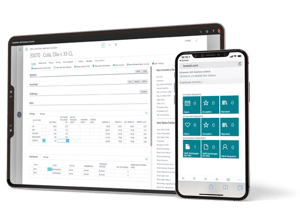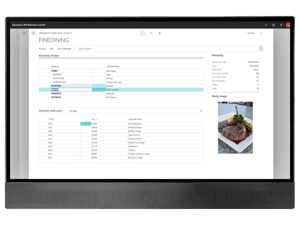3 ways to lower food costs using your restaurant management system

In the low-margin restaurant industry, it is essential to consistently monitor food costs. As restaurants struggle with rising price of ingredients, bottlenecks in the food supply, and limited seating availability, it’s more important than ever for businesses to optimize ingredient buying and usage, and minimize waste.
A good restaurant management system will help you keep track of raw ingredients, menu prices, and spillage and food waste, enabling you to determine where you can make improvements without decreasing quality. Here are three steps you can take.
1. Automate inventory monitoring
In the food and beverage industry, food costs represent on average almost one third of total business expenses.
A unified restaurant management system that connects sales, kitchen and inventory in real time within a single  platform will give you total visibility over usage of ingredients. And if it’s a truly unified platform like LS Central for restaurants, it will also enable you to link your purchasing to recipe management and to actual sales. Stock can then be automatically added to as new inventory is received from distributors, while preset amounts for each ingredient are automatically subtracted from the inventory count when dishes are prepared.
platform will give you total visibility over usage of ingredients. And if it’s a truly unified platform like LS Central for restaurants, it will also enable you to link your purchasing to recipe management and to actual sales. Stock can then be automatically added to as new inventory is received from distributors, while preset amounts for each ingredient are automatically subtracted from the inventory count when dishes are prepared.
Some software systems also enable you to adjust inventory on the fly, using mobile devices to remove from stock the jars that fell on the floor and broke, or the spoiled meat.
All this data can then be organized and analyzed in your back office tools, giving you valuable insight into what might be affecting your bottom line and allowing you to take action.
2. Identify waste patterns and adjust
The US restaurant industry alone wastes over $25 billion worth of food annually, according to a report by waste reduction group ReFED. This is a staggering amount of money being thrown into the garbage.
The first step to managing food waste is to keep track of what you’re throwing away, in what quantities, and why. Use your restaurant management system to keep a regularly updated food waste log. Locate problem dishes, and establish achievable wastage goals for your staff.
Your employees deal with food waste in both the dining room and the kitchen, so it is important that both kitchen and front-of-house staff are trained to minimize common mistakes and correctly report wastage. Implementing a culture of waste monitoring with your employees will encourage staff members to report more detailed waste data. It will also discourage employee theft by clarifying that all inventory, both raw and prepared, is regularly being accounted for.
Once you track your food waste, it’s time to start looking for trends. Perhaps you’ve noticed a dish that consistently returns to the kitchen partially uneaten. Whether it’s the half-eaten pancake or the piles of untouched fries which you end up throwing out, your customers are telling you something about portion size.
With a good restaurant management solution, you can easily adjust your recipes and optimize ingredients and quantities. If your dessert portions are too generous, you could consider getting twelve slices instead of ten from each cake, reducing the amount of whipped cream, or making your cupcakes slightly smaller. The difference might seem tiny at first, but by the end of the month those ounces will add up to savings. By keeping an eye on your waste and adjusting portions accordingly, you’ll produce profit-making dishes, and will have satisfied customers cleaning their plates.
3. Engineer your menu to perfection
Menu engineering is the process of finding the perfect balance of popular low- and high-cost food items. It’s an ongoing practice that uses key performance indicators (KPIs) to help you make data-driven decisions that ensure meals are popular and profit-making.
 If you are using a restaurant management system that gives you real-time business information, you can keep track of your KPIs and see how well your business is performing relative to established targets at all times.
If you are using a restaurant management system that gives you real-time business information, you can keep track of your KPIs and see how well your business is performing relative to established targets at all times.
Use the system to break down the data and see how many times a dish has been ordered, what it costs to produce, and what kind of profit it brings in. By tracking KPIs such as average contribution margins and food cost percentages, you can see how a dish compares to the average profit margin of similar menu items.
Once you have this information, you need to decide which dishes should be kept in your menu, and which ones you should rather replace or discard.
Do you have a menu item that is significantly below the average margin and sells poorly? That should probably go. Is there a popular dish that is slightly below the average margin? Check if it will stay popular even with slightly higher prices. Do you have a low-selling but high-profit dish? Promote it by giving it top center placement on the menu, and remind your servers to suggest it to guests when applicable.
As you calibrate your menu for maximum profitability and customer satisfaction, you will also be adjusting your inventory. Why order bags of live clams when they require careful handling, have a short shelf life, and aren’t frequently ordered? Save yourself both time and money: remove them from your menu and your inventory.
Controlling food costs while providing consistently great meals is essential to your restaurant’s long-term profitability. While it used to require a time-consuming process of manual reporting and calculating, today technology can help you refine your processes and cut costs.
Do you need more information on how a modern restaurant management solution can help you transform your business? Contact us.

